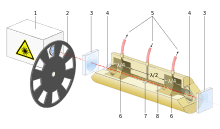Photoacoustic spectroscopy
Photoacoustic spectroscopy is the measurement of the effect of absorbed electromagnetic energy (particularly of light) on matter by means of acoustic detection. The discovery of the photoacoustic effect dates to 1880 when Alexander Graham Bell showed that thin discs emitted sound when exposed to a beam of sunlight that was rapidly interrupted with a rotating slotted disk. The absorbed energy from the light causes local heating and through thermal expansion a pressure wave or sound. Later Bell showed that materials exposed to the non-visible portions of the solar spectrum (i.e., the infrared and the ultraviolet) can also produce sounds.
A photoacoustic spectrum of a sample can be recorded by measuring the sound at different wavelengths of the light. This spectrum can be used to identify the absorbing components of the sample. The photoacoustic effect can be used to study solids, liquids and gases. [1]
Uses and techniques

Photoacoustic spectroscopy has become a powerful technique to study concentrations of gases at the part per billion or even part per trillion levels.[2] Modern photoacoustic detectors still rely on the same principles as Bell’s apparatus; however, to increase the sensitivity, the following modifications have been made:
- Use of intense lasers instead of the sun to illuminate the sample since the intensity of the generated sound is proportional to the light intensity; this technique is referred to as "laser photoacoustic spectroscopy" or "LPAS"[2]
- The ear has been replaced by sensitive microphones. The microphone signals are further amplified and detected using lock-in amplifiers.
- By enclosing the gaseous sample in a cylindrical chamber, the sound signal is amplified by tuning the modulation frequency to an acoustic resonance of the sample cell.
Example
The following example illustrates the potential of the photoacoustic technique: In the early 1970s, Patel and co-workers [3] measured the temporal variation of the concentration of nitric oxide in the stratosphere at an altitude of 28 km with a balloon-borne photoacoustic detector. These measurements provided crucial data bearing on the problem of ozone depletion by man-made nitric oxide emission.
Academic research
While most academic research has concentrated on high resolution instruments, some work has gone in the opposite direction. In the last twenty years, very low cost instruments for applications such as leakage detection and for the control of carbon dioxide concentration have been developed and commercialized. Typically, low cost thermal sources are used which are modulated electronically. Diffusion through semi-permeable disks instead of valves for gas exchange, low-cost microphones, and proprietary signal processing with digital signal processors have brought down the costs of these systems. The future of low-cost applications of photoacoustic spectroscopy may be the realization of fully integrated micromachined photoacoustic instruments.
Recently, the photoacoustic approach has been utilized to quantitatively measure macromolecules, such as proteins. The photoacoustic immunoassay labels and detects target proteins using nanoparticles that can generate strong acoustic signals.[4] The photoacoustics-based protein analysis has also been applied for point-of-care testings.[5]
References
- ↑ David W. Ball Photoacoustic Spectroscopy Spectroscopy, Volume 21, Issue 9, Sep 1, 2006
- 1 2 "Photoacoustic technique 'hears' the sound of dangerous chemical agents", R&D Magazine, rdmag.com, August 14, 2012, retrieved September 8, 2012
- ↑ C.K.N. Patel, E.G. Burkhardt, C.A. Lambert, ‘Spectroscopic Measurements of Stratospheric Nitric Oxide and Water Vapor’, Science, 184, 1173–1176 (1974)
- ↑ Zhao Y, Cao M, McClelland JF, Lu M (2016). "A photoacoustic immunoassay for biomarker detection". Biosensors and Bioelectronics. 85: 261–66. doi:10.1016/j.bios.2016.05.028. PMID 27183276.
- ↑ Zhao Y, Huang Y, Zhao X, McClelland JF, Lu M (2016). "Nanoparticle-based photoacoustic analysis for highly sensitive lateral flow assays". Nanoscale. 8: 19204–19210. doi:10.1039/C6NR05312B. PMID 27834971.
Further reading
- M.W. Sigrist, 1994, Air Monitoring by Spectroscopic Techniques, New York: J. Wiley & Sons.
External links
- General introduction to photoacoustic spectroscopy:
- Photoacoustic spectroscopy in trace gas monitoring
- Photoacoustic spectrometer for trace gas detection based on a Helmholtz Resonant Cell (www.aerovia.fr) [1]
- ↑ Zéninari, Virginie (10 March 2007). "Spectrométrie photoacoustique - Application à l'analyse de gaz".